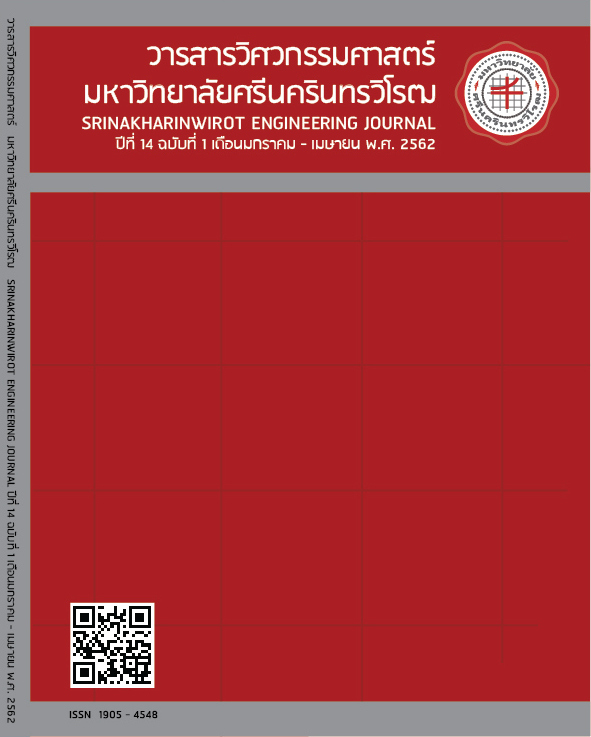Artificial Neural Network Analysis of the Thermal Performance of a Plate Heat Exchanger
Main Article Content
Abstract
This paper proposes the use of artificial neural network (ANN) for the effectiveness and overall heat transfer coefficient using water as working fluid. The experiments are performed using the average inlet hot water temperature between 40 – 50 oC, the average inlet cold water temperature between 20 – 30 oC, the average mass flow rate of hot water between 0.0273 - 0.0444 kg/s and the average mass flow rate of hot water is 0.0196 kg/s. For the ANN model, a single hidden layer structure is chosen and various learning algorithms are applied to adjust errors for obtaining the optimal ANN model. From the experimental results show that the 5 hidden neurons and Levenberg-Marquardt backpropagation learning algorithms is the optimal ANN model. The predicted results are verified with the experimental data and gives R = 0.99631, 0.98469 for effectiveness and overall heat transfer coefficient, respectively.
Article Details
Copyright belongs to Srinakharinwirot University Engineering Journal
References
[2] B.R. Lamb, “Plate heat exchangers, a low cost route to heat recovery”, J. Heat Recovery Syst, vol. 2, no. 3, pp. 247–255, 1982.
[3] Zhiming Xu, Xiaoqiang Wen, Jiaoli Zheng, Jinsheng Guo and Xing Huang, “Cooling water fouling resistance prediction of plate heat exchanger based on partial least squares regression”, Journal of Engineering Thermophysics, vol. 62, no. 6, pp. 1531-1536, 2011.
[4] Guanmin Zhang, Guanqiu Li, Wei Li, Tao Huang and Yucheng Ren, “Experimental and theoretical investigations about particulate fouling in plate heat exchangers”, Journal of Engineering Thermophysics, vol. 34, no. 9, pp. 1715-1718, 2013.
[5] Ruiyun Zheng, Yongcheng Jiang and Xiumu Fang, “Analysis of relative heat transfer coefficient of plate heat exchangers under variable flow conditions”, Heating Ventilating & Air Conditioning, vol. 40, no. 10, pp. 85-88, 2010.
[6] Jing Zhang, Yu Wen, Li Zhao and Deyu Li, Yi Wang, “Heat transfer and flow analysis and corrugation parameters optimization of the plate heat exchanger based on computational fluid dynamics numerical simulation”, Journal of Mechanical Engineering, vol. 51, no. 12, pp. 137-145, 2015.
[7] Jing Wu, Meng Xia, Li Ye and Dong Han, “A numerical study and thermal resistance analysis of heat transfer enhancement in plate heat exchangers”, Journal of Engineering Thermophysics, vol. 33, no. 11, pp. 1963-1966, 2012.
[8] Y. Wang, S. You, W. Zheng, H. Zhang, X. Zheng and Q. Miao, “State space model and robust control of plate heat exchanger for dynamic performance improvement”, Appl. Therm. Eng, vol. 128, pp. 1588-1604, 2018.
[9] Meizhong Shi, Zhongzheng Wang, Principle and Design of Heat Exchangers, Southeast University Press, 2009.
[10] Jorge A.W.Gut, Renato Fernandes, José M. Pinto and Carmen C. Tadini, “Thermal model validation of plate heat exchangers with generalized configurations”, Chemical Engineering Science, vol. 59, no. 21, pp. 4591-4600, 2004.
[11] Peng Ren, Yusheng Wu, “Optimal design for plate heat exchanger by particle swarm optimization”, Energy Technology, vol. 30, no. 5, pp. 270-272, 2009.
[12] Xie G, Zeng M, Luo LQ, “Heat transfer analysis for shell-and-tube heat exchangers with experimental data by artificial neural network approach”, Appl. Therm. Eng., vol. 27, pp. 1096-1104, 2007.
[13] A. Pacheco-Vega, M. Sen and R.L. McClain, “Analysis of fin tube evaporator performance with limited experimental data using artificial neural networks”, in Proc. ASME Heat Transfer Division, 2000, pp. 95–101.
[14] M. Mishra, P.K. Das, S. Sarangi, “Second law based optimisation of crossflow plate-fin heat exchanger design using genetic algorithm”, Appl. Therm. Eng., vol. 29, pp. 2983–2989, 2009.
[15] Tan CK, Ward J, Wilcox SJ and Payne R, “Artificial neural network modeling of the thermal performance of a compact heat exchanger”, Appl. Therm. Eng., vol. 29, pp. 3609-3617, 2009.
[16] M. Mohanraj, S. Jayaraj, C. Muraleedharan, “Applications of artificial neural networks for thermal analysis of heat exchangers - a review”, Int. J. Therm. Sci., vol. 90, pp. 150-172, 2015.
[17] P. Naphon, T. Arisariyawong, “Heat transfer analysis using artificial neural networks of the spirally fluted tubes”, J. Res. Appl. Mech. Eng., vol. 4, no. 2, pp. 135-147, 2016.
[18] P. Naphon, T. Arisariyawong, T. Nualboonrueng, “Artificial Neural Network Analysis on the Heat Transfer and Friction Factor of the Double Tube with Spring Insert”, International Journal of Applied Engineering Research, vol. 11, no. 5, pp. 3542-3549, 2016.
[19] P. Naphon, S. Wiriyasart, T. Arisariyawong, “Artificial neural network analysis the pulsating Nusselt number and friction factor of TiO2/water nanofluids in the spirally coiled tube with magnetic field”, International Journal of Heat and Mass Transfer, vol. 118, pp. 1152-1159, 2018.
[20] P. Naphon , S. Wiriyasart, T. Arisariyawong, L. Nakharintr, “ANN, numerical and experimental analysis on the jet impingement nanofluids flow and heat transfer characteristics in the micro-channel heat sink”, International Journal of Heat and Mass Transfer, vol. 131, pp. 329-340, 2019.
[21] S. Haykin, “Neural networks, A Comprehensive Foundation”, New Jersey, 1994.


